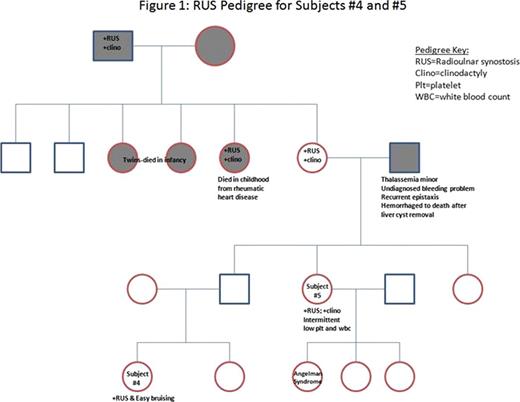Abstract
Abstract 2521
Defects in the radial ray are associated with hematological problems such as thrombocytopenia and bone marrow failure, i.e. Thrombocytopenia Absent Radius Syndrome and Fanconi Anemia. Congenital radioulnar synostosis (RUS), a rare developmental anomaly involving fusion of the bones of the forearms, has been recognized in the orthopedic literature since the mid-1800s. The bony union of the radius and ulna prevents normal supination of the affected forearm, yet the condition is painless and compatible with a normal functional existence without the need for surgery. RUS occurs more frequently in males, and is bilateral in about fifty percent of cases. In utero, growth patterning of the limbs along the various axes requires products of the Homeobox (Hox) genes, which are members of a highly conserved set of transcription gene factors that are expressed very early in embryonic development. In addition to limb patterning, studies regarding homeobox genes have suggested that they are involved in hematopoiesis, including self-renewal, proliferation, differentiation, and leukemogensis. In the year 2000, Thompson and Nguyen published a report in Nature Genetics that identified an unusual association of amegakaryocytic thrombocytopenia and radioulnar synostosis in two unrelated, non-consanguineous families; sequencing of these families found a point mutation of exon 2 of HoxA11. Several other studies have confirmed the association of bone marrow failure or thrombocytopenia and RUS, although a number of patients have not tested positive for the HoxA11 mutation. The aims of our IRB approved project are to create a registry of patients and their family members with congenital RUS with or without hematological problems; compile their medical histories, clinical phenotypes, and results of complete blood counts; archive blood samples; and perform genomic testing for HoxA11 and other DNA screening. We began recruiting subjects at New York Presbyterian Hospital Department of Hematology/Oncology in August of 2009. Through radiology screening, chart review, and referrals from our collaborating pediatric orthopedists, we have identified eight source patients with RUS. All except one patient have hematological manifestations; three have subtle symptoms of easy bruising and recurrent epistaxis, one had thrombocytopenia with reduced megakaryoctyes, one has intermittent thrombocytopenia and leucopenia of undetermined etiology, one had pancytopenia/bone marrow failure in infancy and is status post bone marrow transplant (s/p BMT), and one had acute lymphoblastic leukemia/lymphoma in young adulthood and is also s/p BMT. The eighth patient was recently adopted from an orphanage in a foreign country, and his past and family histories are unknown. Other related anomalies or syndromes found in the primary subjects or family members are clinodactyly of the 5th finger, Angelman Syndrome, Autism Spectrum Disorders, Pulmonary Hypertension (PHTN), Polycystic Kidney Disease (PCKD), and possible Poland Syndrome. We have also compiled family pedigrees and collected blood from immediate family members, some of whom also have RUS and hematological manifestatations [Figure 1]. Five of the eight families are of Mediterranean (mostly Italian) ancestry, suggesting a possible founder effect to the mutation versus geographic bias of the New York metropolitan area. One family of Italian descent had consanguinity of the subject's maternal grandparents. We are in the process of sequencing HoxA11 for the subjects and their families. Subject #1 previously tested normal for the HoxA11 gene. If samples are determined to be normal for HoxA11, genome wide SNP analysis for further homozygosity and/or linkage mapping will be pursued. We hope to increase awareness of the linked clinical entities of RUS, thrombocytopenia, bone marrow failure, and possible malignant transformation at the level of the general pediatrician, orthopedists, and hematologists. Additionally, besides HoxA11, we hope to discover other candidate genes or molecular mechanisms within related Hox genes that may influence the development of forearm morphogenesis, thrombopoiesis, and leukemogenesis.
Disclosures:
No relevant conflicts of interest to declare.
Author notes
*
Asterisk with author names denotes non-ASH members.
© 2010 by The American Society of Hematology
2010


This feature is available to Subscribers Only
Sign In or Create an Account Close Modal